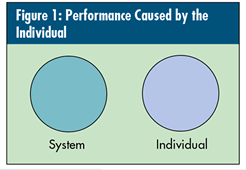Decision-making with respect to improving performance is a matter of prediction. So is leadership. For example, was the energy crisis a rational, predictive event 30 years ago? Or was it random, unpredictable, and unpreventable? If it’s the latter, then we must believe that we are morons with no theory, knowledge, or predictive capability, and are powerless to influence our environment or future. No reasonable person accepts that.
People in business, education, and government make decisions to create positive outcomes for themselves and their organizations. There are basically three categories of decisions:
1. Decide to take some form of action. (We can cause a positive result.)
2. Decide to take no action. (The status quo is just fine, thank you.)
3. Decide not to decide. (i.e., management by paralysis)
To make better decisions and improve future performance, we need to understand what drives performance. There can only be two major components that affect performance independently, or interactively, and those are the systems that are being used in the creation of the business outcomes and the performance of people working in and around these systems. The diagrams in figures 1 and 2 show the possible basis of performance.

…
Comments
Add new comment